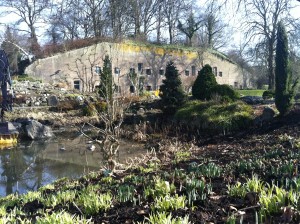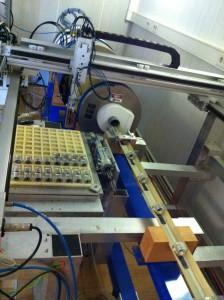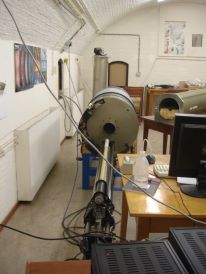I’m coming to the end of a 5 week visit to The Fort Hoofddijk, the Palaeomagnetism Laboratory at the University of Utrecht, in the Netherlands. I’ve been carrying out a number of experiments, the results of which I am hoping to present at this year’s European Geosciences Union (EGU) Assembly, in Vienna (7th – 12th April).
The Building
 The building which houses the lab is pretty impressive, as it is a 19th Century bunker, within the grounds of the botanical gardens at the University. Most of the equipment is found at the back of the building, in what used to be the old gunpowder storage rooms. It lacks any windows, so experiments are conducted without natural light, which reminds me of this comic. Learn more about the building here.
The building which houses the lab is pretty impressive, as it is a 19th Century bunker, within the grounds of the botanical gardens at the University. Most of the equipment is found at the back of the building, in what used to be the old gunpowder storage rooms. It lacks any windows, so experiments are conducted without natural light, which reminds me of this comic. Learn more about the building here.
There are strong links and collaborations between the Liverpool Geomagnetism Lab and ‘The Fort’ (as the Utrecht lab is often called). My PhD project is co-supervised by Cor Langereis, who heads up The Fort. In addition, Andy, Mimi and Megan are involved with projects with students at The Fort. I also hear that Andreas and Emma meet Wout Krijgsman (also of The Fort) during their recent sampling trip to New Zealand.
Why the Fort?
The answer is simple, doing experiments at The Fort, saves me a lot of time!
This is my fourth visit to The Fort. I’ve visited often because they have equipment which we don’t, yet, have at Liverpool. Whilst at the Fort, I regularly use their2G Enterprises DC-SQUID magnetometer (which happens to be the first ever made) and also, an in house built, robotised AF demagnetiser attached to a 2G Enterprises RF-SQUID magnetometer (the Robot). The Robot
is a nifty piece of kit, allowing you to alternating field(AF) demagentise 96 samples without you actually having to do any measuring, which any palaeomagnetist will tell you, is a GREAT advantage! It saves huge amounts of measuring man hours. You prepare the samples by placing them in cubes, which act as sample holders, and load these onto a tray made up of 12 rows, which take 8 samples each. You then produce a file which tells the computer how you want the experiment to run and press GO, and leave it to do its thing. Provided everything works fine, it takes the robot, on average, 48hrs to measure a full batch of 96 samples. The samples I’ve been working with are not standard palaeomagnetism size, (standard being 1 inch). This means I need to use special holders, of which there are only 15 available. A full AF demagentisation of two rows takes less than 12hrs. Whilst here, I’ve also been running some manual AF demagentisation experiments on the AF demagentiser, and a full experiment has taken me 36 man hours to complete. I could conduct my experiments at Liverpool, and to some extent, I do, but they are considerably more time consuming than doing them here at the Fort!
A Typical Day
The 2G Enterprises DC-SQUID magnetometer (2G, from now on)
is usually in high demand, especially after spring and summer, when most of the field work takes place. Students and staff come back from this expeditions loaded with samples, which they are keen to get measuring asap. As a result, a shift system is in place to use the 2G. The first shift runs from 6am-3pm, the second from 3pm to midnight and the graveyard shift runs from midnight to 6am. February isn’t too busy a time, so I’ve been lucky to get the day time shift from 6am onwards.
The squids on the 2G need a little time to stabilise after being turned on, so that is my first task – get everything switched on and ready to go. In the time it takes for the squids to stabilise I can prepare breakfast and get the samples ready to be measured. I usually run two batches of samples concurrently: whilst one batch (of anything between 30 and 45 samples) is heating in the oven, I measure the other on the 2G. The samples I’m working on at the moment don’t respond well to thermal demagnetisation (TH), as I see them altering quite a lot. Therefore, I’ve been carrying out AF demagnetisations too. These only take a couple of minutes to complete, unlike the TH demagnetisations, where the samples have to sit in the oven for an hour. I perform the AF demagenetisations and measure the samples whilst the TH batch is heating in the oven. In a nine hour shift, I repeat this process four times, twice for AF batches and twice for TH batches. It’s a pretty repetitive task, so you have to keep yourself entertained, either by watching a film, listening to music, or writing this blog post!
A little thank you
I’d like to take this opportunity to thank everyone at The Fort for all their help during my time here (on this visit, and all my previous ones). I’d especially like to mention Tom Mullender and Maxim Krasnoperov, for all their technical support and teaching me how to use all the equipment. Also, Cor Langereis for his hospitality and valuable discussions!



Leave a Reply